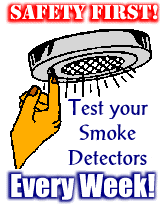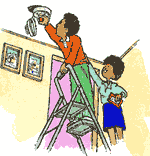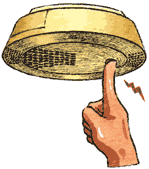
Safety
Tips: Installing/testing smoke alarms
These easy
safety tips can keep your whole family safer.

|

|
|
Ceiling-mounted
alarms should be installed at least four inches away
from the nearest wall.
|
|
|
Tips for installing
your smoke alarms correctly:
Install smoke alarms
Listed (examined and tested to appropriate product safety standards) by a
qualified testing laboratory on every level of your home, including the
basement (but not unfinished attics). Make sure there is an alarm in or near
every sleeping area.
- Mount the smoke
alarms high on ceilings or walls – remember, smoke rises. Ceiling-mounted
alarms should be installed at least four inches away from the nearest wall;
wall-mounted alarms should be installed four to 12 inches away from the
ceiling.
- Don't install smoke
alarms near windows, outside doors, or ducts where drafts might interfere with
their operation.
- Don't paint your
smoke alarms; paint or other decorations could keep them from working when you
most need it.
|

|
|
Test
your smoke alarms at least once a month by using the
alarms' "test button."
|
|
|
Tips for keeping your
smoke alarms working properly:
Test your smoke
alarms at least once a month by using the alarms' "test button." Never
use an open-flame device to test the alarm as you could burn yourself or start a
fire. If the smoke alarm manufacturer's instructions permit the use of an
aerosol smoke product for testing the smoke alarm, only use one that has been
Listed by a third-party product testing agency, and utilize it in accordance
with the product instructions.
- Replace the
batteries in your smoke alarms once a year, or as soon as the alarm
"chirps," warning that the battery is low. Helpful
hint: schedule
battery replacements for the same day you change your clock from daylight to
standard time in the fall.
- Regularly
vacuuming or dusting your smoke alarm following manufacturer's instructions
can help keep it working properly.
- Replace your smoke
alarms once every 10 years.
- Never
"borrow" a battery from a smoke alarm.
- Make sure that
everyone in your home can hear and recognize the sound of the alarm and
knows how to react immediately.


Thanks to: NFPA
Online



![]()
![]()